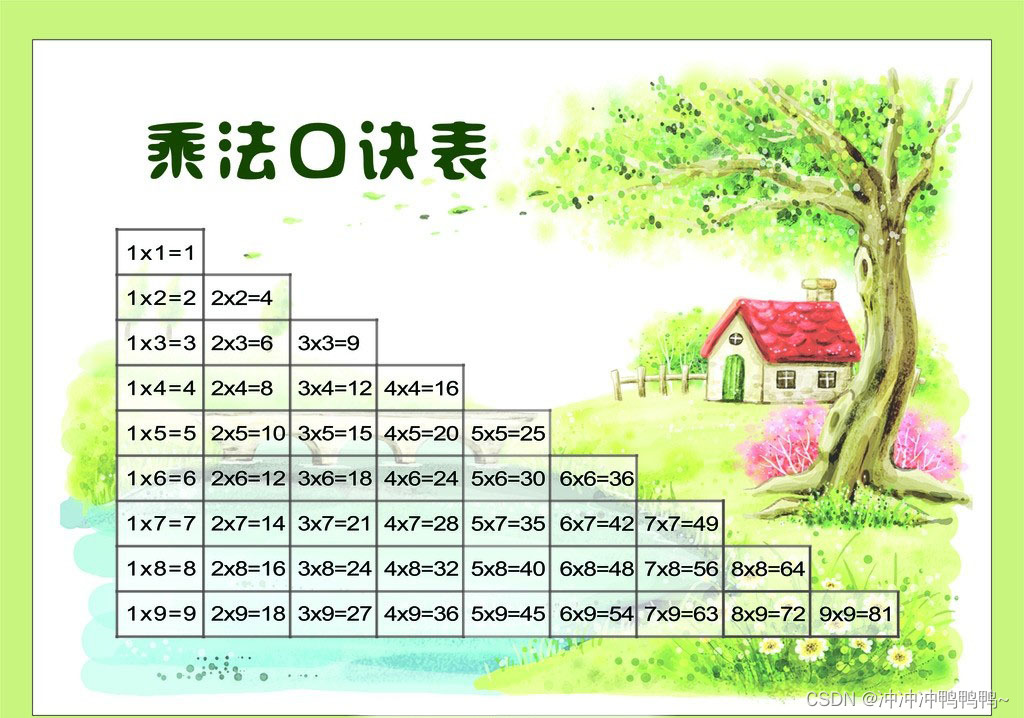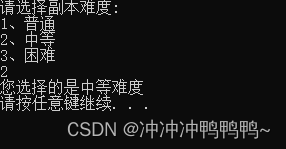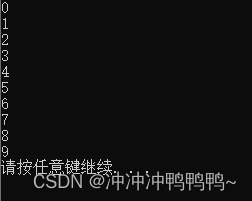目录
P37程序流程结构-嵌套循环
作用:在循环体中再嵌套一层循环,结局实际问题
例如我们想在屏幕中打印如下图片,就需要利用嵌套循环

#include <iostream>
using namespace std;
int main() {
for (int i = 1; i <= 10; i++) {
for (int j = 1; j <= 10; j++) {
cout << "*"<<" ";
}
cout << endl;
}
system("pause");
return 0;
}运行后的结果为:

P38程序流程结构-嵌套循环案例-乘法口诀表

int main() {
for (int i = 1; i < 10; i++) {
for (int j = 1; j <= i; j++) {
cout << i << "*" << j << "="<<i * j <<" ";
}
cout << endl;
}
system("pause");
return 0;
}运行后的结果为:

P39程序流程结构-调转语句-break语句
作用:用于跳出选择结构或者循环结构
break使用的时机:
- 出现在switch条件语句中,作用时终止case并跳出switch;
- 出现在循坏语句中,作用时跳出当前循环语句;
- 出现在嵌套循环中,作用时跳出最近的内层循环;
示例:
1、出现在switch条件语句中,作用时终止case并跳出switc
#include <iostream>
using namespace std;
int main() {
// break使用时机
//1、使用在switch语句中,用于终止case并跳出switch
cout << "请选择副本难度:" << endl;
cout << "1、普通" << endl;
cout << "2、中等" << endl;
cout << "3、困难" << endl;
int num = 0;
cin >> num;
switch (num) {
case 1:
cout << "您选择的是普通难度" << endl;
break;
case 2:
cout << "您选择的是中等难度" << endl;
break;
case 3:
cout << "您选择的是困难难度" << endl;
break;
}
system("pause");
return 0;
}运行后的结果为:

若没有break,运行后的结果为:

2、出现在循坏语句中,作用时跳出当前循环语句;(以for循环为例)
若没有break:
for (int i = 0; i < 10; i++) {
cout << i << endl;
}运行后的结果为:

若加入break:
for (int i = 0; i < 10; i++) {
if (i == 5) {
break;
}
cout << i << endl;
}运行后的结果为:

3、出现在嵌套循环中,作用时跳出最近的内层循环
for (int i = 0; i < 10; i++)
{
for (int j = 0; j < 10; j++)
{
if (j == 5)
{
break;
}
cout << "*" << " ";
}
cout << endl;
}运行后的结果为:

P40程序流程结构-跳转语句-continue
作用:在循环语句中,跳过本次循环中余下尚未执行的语句,继续执行下一次循环
示例:
int main() {
for (int i = 0; i < 10; i++)
{
if (i % 2 == 0)
{
continue;//可以筛选条件, 执行到此就不再向下执行,执行下一次循环
}
cout << i << endl;
}
system("pause");
return 0;
}运行后的结果为:

P41程序流程结构-跳转语句-goto
作用:可以无条件跳转语句
语法: goto 标记;
解释:如果标记的名称存在,执行到goto语句时,会跳转到标记的位置
示例:
int main() {
cout << "1" << endl;
goto FLAG;
cout << "2" << endl;
cout << "3" << endl;
cout << "4" << endl;
FLAG:
cout << "5" << endl;
system("pause");
return 0;
}注意:在程序中不建议使用goto语句,以免造成程序流程混乱
本文含有隐藏内容,请 开通VIP 后查看